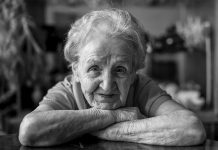What you’re doing, right now, at this very moment, is killing you. More than cars or the Internet or even that little mobile device we keep talking about, the technology you’re using the most almost every day is this: your tush. Nowadays people are sitting 9.3 hours a day, which is more than we’re sleeping, at 7.7 hours. Sitting is so incredibly prevalent, we don’t even question how much we’re doing it, and because everyone else is doing it, it doesn’t even occur to us that it’s not okay. In that way, sitting is the new smoking.[1]
This frank warning about the scale and risks of a sedentary lifestyle was given by someone who isn’t even involved in the fields of medicine or exercise science. Nilofer Merchant, who currently teaches at Stanford University, is considered one of the most influential management specialists—she has launched more than 100 products generating over 18 billion dollars in sales, she is invited to hundreds of leadership events around the world by prestigious organisations, and she received The Future Thinker Award in 2013.
In an article advocating for physical activity, Merchant confesses that all the information about the harmfulness of a sedentary lifestyle was not able to convince her to do more exercise. Not because she didn’t want to, but because her agenda was already full of “more productive” activities she engaged in for her company or family. That was until she realised that she could combine work and exercise, replacing the usual sit-down meetings with walking meetings.
Although she was not surprised that a third of her clients refused the invitation to walk with her, under the pretext of lack of fitness, Merchant managed to rack up between 30 and 50 kilometres a week during her walking business meetings.
The woman confesses that this unconventional idea changed her life, teaching her that work and health should not be in an antagonistic relationship.
In general, we are excited about stories that capture the transition from a sedentary lifestyle to an active one, but when it comes to inserting physical movement into our own agenda, we easily lose momentum. In fact, the trend of today’s generation is to extend the time spent on a chair or the couch, whether it is for work or leisure, so that physical activity has moved from being the centre of a busy day to the periphery.
Sitting champions
Sedentary lifestyles affect children and adolescents to a greater degree than adults, according to a study published in 2017, which found that the level of physical activity of 19-year-olds is similar to that of 60-year-olds.
Analysing data from over 12 000 people aged 6 to 84 who wore physical activity monitoring devices, the researchers found that the time spent on exercise decreases during adolescence. Although children should, according to the World Health Organization (WHO), benefit from at least one hour of moderate to vigorous exercise a day, the study showed that 25% of boys aged 6-11 and 50% of girls of the same age had activity levels below the WHO recommendations. The number of adolescents who did not follow these guidelines was even higher: 50% of boys and 75% of girls in their teens failed to be active for even an hour a day.
“It was certainly a big surprise,” said Vadim Zipunnikov, the study’s coordinator, who said that a major factor in the lack of physical activity in children could be insufficient sleep.
Americans of all ages have extended their sitting time, but of all age groups, teens have become the most sedentary, according to a study published in 2019 in the Journal of the American Medical Association. Analysing data of 52 000 subjects, the researchers found that, between 2007 and 2016, the average time spent in a sitting position increased from 5.5 hours to 6.4 hours a day, in the case of adults, and from 7 to 8.2 hours a day in adolescents. At least 3 hours of this time is spent browsing online or watching television programs, say the study’s authors, warning that this sedentary behaviour is associated with obesity and an increased risk of cardiovascular disease, cancer, and diabetes.
“It is very worrying to see such an increase in sedentary behaviour in all age groups. We have found that sedentary habits accompany individuals as they grow older so it is very important that we begin to address this issue with younger generations,” said Yin Cao of the University of Washington, St. Louis campus.
The many consequences of a sedentary lifestyle
Globally, one in five individuals do not engage in enough physical activity, warns a study published in 2011, following the monitoring of 300,000 people in 76 countries. Physical inactivity has already become a public health problem as it increases the risk of serious noncommunicable diseases, such as coronary heart disease and certain cancers, according to a study published in 2012 in the Lancet, which aims to quantify the effect of sedentary lifestyle on health. The researchers estimated that the lack of physical activity is responsible for 6% of cases of coronary heart disease globally, 7% of cases of type 2 diabetes, 10% of cases of breast cancer and 10% of those of colon cancer and 9% of cases of premature mortality. Studies have shown that there is a link between sedentary behaviour and anxiety, and the World Health Organization recommends physical activity in combating depression.
That sedentarism literally kills was the stark conclusion of a 2017 study, led by Keith Diaz, a researcher at Columbia University’s School of Medicine. Diaz’s team monitored, for a period of 4 years, nearly 8 000 people aged 45 years or older. The research revealed that on average, the sedentary time of the subjects amounted to 12.3 hours out of the 16 spent awake. During the study, 340 deaths were recorded, the researchers finding that as the sedentary time increased, the risk of premature death from any cause increased, regardless of the race, age, sex or body mass index of the subjects.
“We have found that there is no threshold or limit above which the risk of death has increased dramatically. However, to provide some figures, those who spent more than 13 hours sitting had a 200% higher risk of death than those who sat less than 11 hours a day “, Diaz said.
“People with uninterrupted sedentary periods of 30 minutes or more had the highest risk of death if the total sedentary time also exceeded 12.5 hours a day,” said David Alter, a professor at the University of Toronto.
A second study coordinated by Diaz would also suggest a possible remedy: by replacing a 30-minute sit with low-intensity physical activity, the risk of early death decreases by 17%, and in the case of moderate or intense activity, the risk decreases by 35%.
However, sitting down for hours cannot be compensated for simply by exercise, warns a study that shows that a person who spends his day working in a chair but exercises in the evening has a 40% higher risk of death than one who sits down for less than 3 hours a day. “It’s not just about sports. Even if you do 30 minutes of exercise a day, what about the other 23.5 hours a day? Don’t sit down for the rest of the day, ”says Dr. Peter Katzmarzyk of the Pennington Biomedical Research Centre in Baton Rouge, Louisiana.
When old age and illness are not inevitable
Physical exercise affects the duration and quality of life. This is the leitmotif of a long series of studies that have analysed the impact that an active lifestyle has on a person’s well-being. The health of our brains and the degree of training of our muscles are interconnected to a greater extent than we imagine, says Teresa Liu-Ambrose, a professor in the Department of Physical Therapy at the University of British Columbia. She coordinated a study that showed that weight training improves not only memory, but also the executive functions of the brains of women with early signs of dementia. Liu sends an extremely encouraging message to seniors:
“Even if you start to see signs of cognitive impairment, the brain is still able to recover, with proper physical activity. Weight-lifting exercises, even once or twice a week, can minimize the rate of cognitive decline and change the course of the disease.”
Following intense physical activity, in short periods of time, even tumour cells can slow their growth, at least in the case of rectal cancer, although the mechanism by which this reaction is obtained is not very clear. Tina Skinner, the study’s coordinator, says that while amazing, the results still need to be treated with caution, as the changes have been transient, with no clear information yet on how long exercise should take to make a difference in cancer progression or about the possibility of extending these effects to other forms of cancer. In any case, the results are encouraging enough to recommend the incorporation of exercise in the standard practice of caring for people with cancer, but also for healthy ones, says Skinner.[2]
The cardiovascular system and muscles of older people who have been physically active throughout their lives age to a lesser extent, was the conclusion of a study that looked simultaneously at three different groups: elderly people who have been physically inactive throughout their lives, elders who practiced cycling, swimming or walking as a decades-long hobby, and physically active 20-year-olds. The muscular system of the active elderly was in a similar shape to that of the young, being difficult to differentiate in many respects. Also, the aerobic capacity of the active elderly was 40% higher than that of their sedentary peers, and their cardiovascular system was in as good a shape as if the subjects were 30 years younger.
The effects of a sedentary lifestyle could be at least partially reversible, was the conclusion highlighted by a large study published in 2019. Subjects were grouped according to the level of physical activity during their lives. Predictably, people who were sedentary throughout their lives had the highest risk of mortality, especially due to cardiovascular disease. Active people had a 30-35% lower mortality risk from any cause and a 40% lower risk of dying from a heart attack, compared to the inactive group. Surprisingly, individuals who were sedentary for a decade or two but increased their level of physical activity at 40 or 50 years of age for at least a few hours per week enjoyed a level of protection against premature death similar to that of the group that had been active throughout life. The bad news of the study was that people who were active in adolescence and youth and then became sedentary had, at middle age, about the same risk of death as the group that had always been inactive.
The message of this investigation is twofold, says researcher Pedro Saint-Maurice of the National Cancer Institute: “If you are physically active right now, keep going. But if you haven’t been active lately, it seems like it’s not too late (to start), even if you’re in the middle of life.”
Although we may imagine that only a marathon preparation would propel us on a path that is truly beneficial to our health, the truth is that even short, low-intensity rounds of exercise can pay dividends to our well-being. A minimum threshold of physical activity could significantly reduce the risk of mortality from cancer, cardiovascular disease and other conditions, suggests a recent study that encourages investing 10-60 minutes in physical activities such as gardening or walking.
However, this does not mean that the target should be the minimum threshold, the WHO recommendation being to take 10,000 steps every day. But, as the saying goes, “no matter how slow you go, you’re still an athlete compared to someone who sits on the couch.”
Carmen Lăiu is a writer for ST Network and Semnele timpului.


















